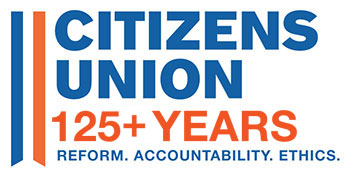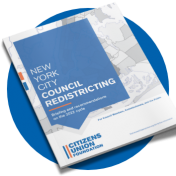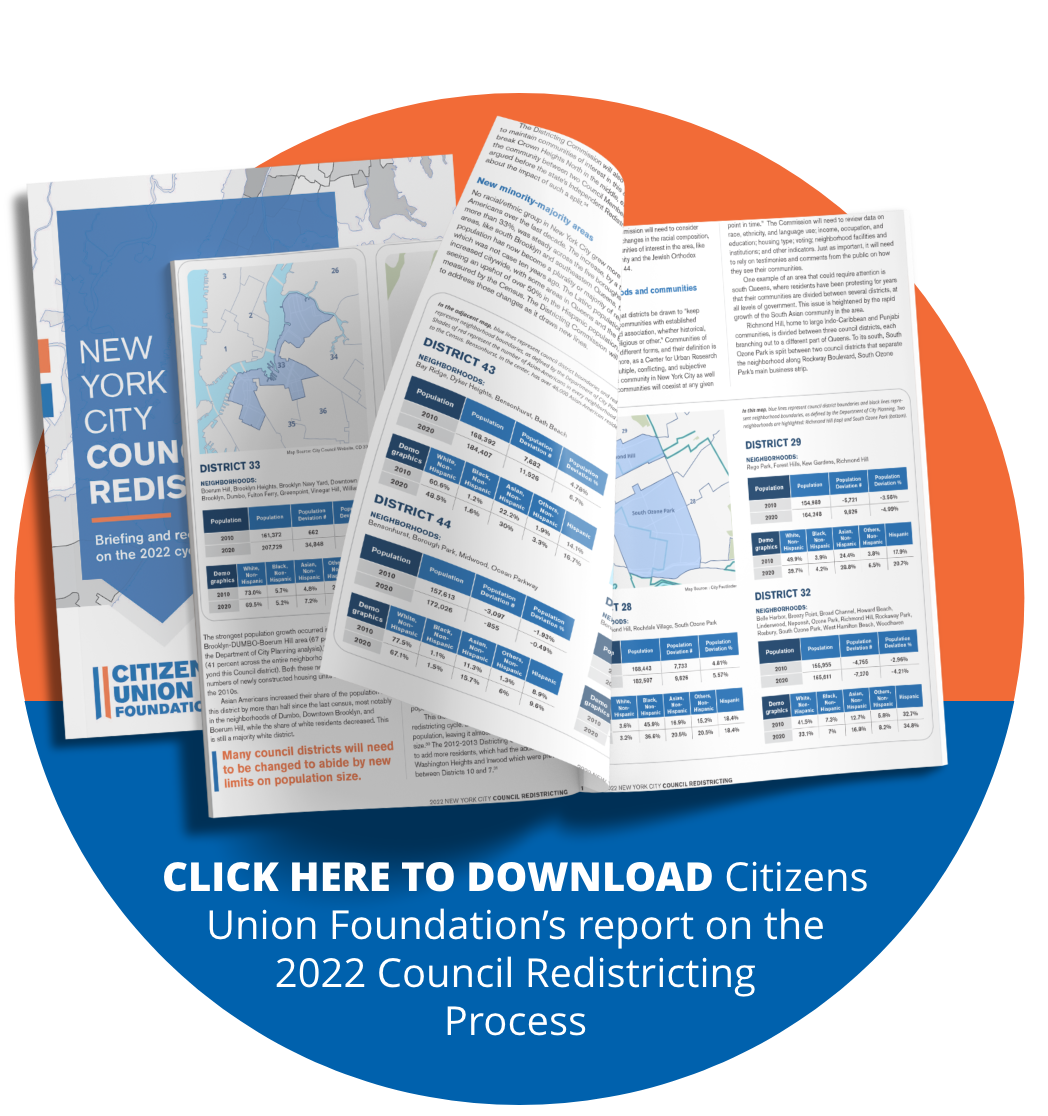The New York City Districting Commission Approved Final City Council District Maps on November 1, 2022
City Council
Redistricting is now
done
What should your City Council District look like?
New boundaries will reflect population changes from the last ten years, input from communities, and legal guidelines.
The first draft maps were published in July, and public hearings to comments on the maps were held in August.
Download our free report on the 2022 Council Redistricting with details about what you can do to make your voice heard.
Following the decennial nationwide census, the New York City Charter mandates that the City Council and the Mayor appoint a Districting Commission to redraw council district boundaries to reflect population and demographic changes. In the coming year, the Districting Commission will have to draw new borders in a city that has undergone significant demographic shifts in the past 10 years.
Process Overview
In New York City, City Council districts are not drawn by lawmakers themselves but by a special commission called the Districting Commission. The members of the Commission are appointed by the mayor and by the Democrats and Republicans serving on the City Council, but once appointed, the commissioners act independently of the political figures who appointed them.
Commissioners must follow specific legal criteria that guide how boundaries are drawn, and they have to ask for feedback on every proposed map. The City Council can object to the first plan the Commission submits and send it back for a revision. Once the Commission approves a revised, final plan, neither Council Members nor the mayor can legally change the maps. The process takes about ten months, but the new districts remain in place for ten years.
Take Action: Make Your Voice Heard
CITIZENS UNION TRAININGS
With the support of the New York Community Trust, Citizens Union Foundation is offering free trainings and resources to community groups all over the city to help New Yorkers engage in the Council redistricting process. The training includes information on:
- The basics of Council redistricting.
- Why engaging in the Council redistricting process is important.
- An overview of the process and the criteria used to draw the maps.
- How to look at and create your own maps.
- How to testify before the Council’s Districting Commission.
- The essential elements of an effective testimony.
We would be more than happy to tailor the content of our training to meet the needs your group. We can offer a short presentation (i.e. a ten minute basic overview), a full length 75 minute presentation, or anything in between.
The Districting Commission has released the first draft of maps on July 15th, and public hearings to comment on those maps will be held in August. Preliminary public hearings were held in late June and early July. We are holding trainings in April to August, and will continue throughout the entirety of 2022, as necessary. We can hold trainings in person or on zoom, and can be flexible in regards to time and day to best accommodate your needs.
TRAININGS CALENDAR
Not all trainings are open to the public. Contact us if you would like to join a training. UPDATE: Trainings are paused until a new round of public hearings is announced.
JUNE 2022
June 6: (Virtual) Redistricting Training (Brooklyn)
June 6: Redistricting Training (Brooklyn)
June 6: Redistricting Training (Brooklyn)
June 6: (Virtual) Redistricting Training (Brooklyn)
June 6: Redistricting Training (Brooklyn)
June 6: (Virtual) Redistricting Training (Brooklyn)
June 6: Redistricting Training (Brooklyn)
June 6: Redistricting Training (Brooklyn)
June 6: (Virtual) Redistricting Training (Brooklyn)
June 6: Redistricting Training (Brooklyn)
RECORDED TRAININGS
Latest from CU
- November 1, 2022: Citizens Union Responds to NYC Districting Commission Approval of the Final City Council District Maps, Ending a Ten-Month Long Process
- October 7, 2022: Letter to Speaker Adams on reducing further delays to the redistricting process
- October 6, 2022: Citizens Union Responds to NYC Districting Commission’s Revised City Council District Maps, Calls on Council to Act Immediately
- September 30, 2022: Citizens Union Applauds NYC Districting Commission for Open Map Drawing Sessions, Allowing Public to See How City Council District Maps Are Drawn
- September 22, 2022: Citizens Union Responds to NYC Districting Commission Voting Down Proposed City Council District Maps
- August 16, 2022: Citizens Union’s written testimony for the second round of public hearings
- August 10, 2002: Watchdog and community groups urge the Districting Commission to make mapping negotiations in public
- July 7, 2002: Citizens Union’s testimony at the Staten Island public hearing
- June 6, 2022: Citizens Union responds to NYC Districting Commission’s decision to delay draft maps and hold additional public hearings
- May 26, 2022: Citizens Union’s testimony at the Districting Commission’s first preliminary public hearing
- May 18, 2022: CU, LatinoJustice, APA VOICE urge Commission to hold public hearings before releasing first draft redistricting plan
- May 6, 2022: Letter to NYC Districting commissioners with Citizens Union’s recommendations
- May 2, 2022: Letter to Districting Commission Chair Concerning a possible Code of Ethics
- January 27, 2022: Letter to the Mayor and the City Council with recommendations regarding the Districting Commission (Mayor, Speaker, Minority Leader, Council Members)
Resources
Read a memo explaining how current districts were drawn in 2013 (pdf file)
Frequently Asked Questions (FAQs)
Why is it important?
New York City Council Members hold unique powers to directly impact the communities they represent, in ways that state senators or assembly members cannot. Each Council Member gets to decide how to spend about $5 million in capital funds annually, to be spent on improvements to the district like construction in schools or playgrounds. The Council Member can also spend about $500,000 to help non-profit groups in the district. By tradition, the Council Member is given great deference in Council decisions on rezoning plans in their district. Their opinion on other land-use decisions also carries weight. And they serve as their constituents’ voice in city government.
Those broad discretionary powers to impact a neighborhood’s built environment and civic institutions highlight how important it is for communities to be truly represented by their Council Member. A redistricting process that leaves communities unfairly partitioned would lead to communities being unfairly ignored. Indeed, splitting communities into a few different political districts often leads to reduced public investment and services in education, health, and other areas. Divided communities are found in all five boroughs, but population change over the decade years has exacerbated the situation in areas like south Brooklyn and Southeast Queens.
Who draws the map?
The Districting Commission is made up of 15 members. The majority conference in the City Council appoints five members – one from every borough. The minority conference in the City Council appoints three members – residents of three different boroughs. The mayor appoints seven members, and in making the final appointments, the mayor needs to ensure the Commission as a whole abides by legal standards on representation and party composition. Once appointed, the 15 commissioners elect their own chair, hire an Executive Director and start recruiting staff. The City Charter places some requirements to the composition of the Commission. For example, racial and minority groups protected by the 1965 Voting Rights Act must be adequately represented on the Commission, roughly proportional to the city’s demographics. Commissioners cannot be government employees, political party officials, or registered lobbyists. The Commission cannot have a majority of commissioners who are enrolled in the same party. See a list of current commissioners here.
How are districts redrawn?
The Commission is obligated to redraw district boundaries based on legal requirements set by the U.S. Constitution, federal law, state law, and the City Charter. The Council districting plan must:
- Abide by “one-person, one-vote”. The U.S. Constitution requires legislative districts to have roughly equal population size. Under New York State law, the difference between the least populous and the most populous Council district cannot exceed 5%.
- Protect minority vote. The 1965 federal Voting Rights Act forbids the new district maps from diluting the voting power of racial and language minority groups. The City Charter also includes a similar provision that ensures “fair and effective representation” for minority groups.
- Have only contiguous districts. According to the Charter, each council district must be contiguous, and if parts of a district are separated by a body of water there must be a bridge, a tunnel, a tramway or regular ferry service connecting the areas.
- Not have more than one crossover district per set of two boroughs. The Charter states that a district shall not cross borough or county boundaries, “to the greatest extent possible”. If there is need to create a district that crosses two boroughs, as has been the case in previous redistricting cycles, then it may only occur once per set of boroughs.
The Charter lists the following redistricting criteria but prioritizes them and provides the commission some wiggle room by noting criteria must be followed “to the maximum extent practicable”. The districting plan should follow these rules, prioritized in the order in which they are listed:
- Keep neighborhoods and communities of interest intact. One of the most important criteria for drawing new maps, which is used by New Yorkers that testify before the Commission, requires district lines to keep intact neighborhoods and communities of interest, meaning communities “with established ties of common interest and association, whether historical, racial, economic, ethnic, religious or other.” Neighborhoods include uninhabited places uniquely connected to the community, like a waterfront. And communities could be defined by various common factors, like country of origin, broadcast and print media, employment, schools, and public transportation. However, final maps can split communities of interests if that is necessary to comply with “one person, one vote” or Voting Rights Act criteria.
- Keep districts compact. Each district shall be compact, such that no district is drawn to be more than twice as long as it is wide.
- Prevent partisan gerrymandering. Districts cannot be drawn in order to diminish the effective representation of voters enrolled in the same political party. This refers to intentional discrimination against a group of party voters. An actual effect of diluting their vote does not need to be shown
- Avoid oddly shaped districts. The districting plan as a whole should be compact – it should minimize the total length of district boundaries. This is meant to prevent “strange” and non-standard shapes of districts, which are often indicative of gerrymandering.
For more information on the redistricting criteria and procedures, click here to read Citizens Union Foundation’s report on the 2022 Council Redistricting Process
How is this different from congressional and legislative redistricting?
New York City’s redistricting process is different from New York State’s congressional and state legislative redistricting. It is run by a different commission that follows a different set of rules. Unlike what happened at the state level, where the legislature ultimately took control over the maps – and the courts then invalidated the plans – the City Council has no authority to veto the final maps that the City Districting Commission submits. So long as the commission votes to approve the maps, they will be adopted, and the City Council has no power to change them. This guarantees a level of independence from legislators that did not exist at the state level. In addition, while state-level redistricting happened under a whole new set of rules and processes, New York City has been using the same process to redraw Council lines for three decades. Citizen input can, and often does, have sway on ultimate district lines. Previous commissions have provided justifications for every district, showing how map-drawers accommodated what they heard from the public during testimonies.
Timeline for 2022 redistricting [updated]
- April: The Districting Commission holds its first meeting
- Preliminary round of public hearings
- May 26 – Manhattan public hearing
- June 27 – Queens public hearing
- June 29 – Brooklyn public hearing
- July 6 – Bronx public hearing
- July 7 – Staten Island public hearing
- July 15: Districting Commission presents a draft of the first redistricting plan to the public
- August: Borough-based public hearings, feedback on the draft of the plan
- August 16 – Queens public hearing
- August 17 – Bronx public hearing
- August 18 – Staten Island public hearing
- August 21 – Brooklyn public hearing
- August 22 – Manhattan public hearing
- September 22: Districting Commission votes to submit the first redistricting plan to the City Council [plan voted down]
- September 29 & 30: Districting Commission meets in public to deliberate maps
- October 6: Districting Commission votes again to submit the first redistricting plan to the City Council.
- October 27: The deadline for the City Council to object to the proposed plan and send it back for revision. New maps are automatically adopted unless the Council votes to object to them within three weeks.
- Early November (assessment): Deadline for the Districting Commission to make its revised redistricting plan available to the public
- November-December (assessment): Second round of public hearings, feedback on the draft of the revised plan
- December 2022-January 2023 (Likely): Districting Commission submits its second and final redistricting plan to the City Council. The Charter-mandated deadline for submitting a plan is December 7, but the Commission has previously extended those timelines.
- The Council cannot object to the second, final plan, which is formally adopted after it is properly filed with the City Clerk.
- February 28, 2023: Beginning of petitioning process for City Council primary election
News
- May 10, 2023, Queens Daily Eagle: Court rules against Queens redistricting lawsuit
- May 8, 2023, Gothamist: Judge orders NYC Council district lines to remain in place for upcoming election
- March 14, 2023, Gothamist: Déjà vu? 2 summer primaries could be in store for NYC voters
- February 24, 2023, Queens Daily Eagle: Advocates sue city over redistricting lines in Queens
- November 3, 2022: Queens Chronicle: New Council districts all set
- November 1, QNS: Residents furious as newly approved City Council district map splits Glendale in two
- October 28, City & State: City Council approves redistricting maps, and only one member is furious
- October 27, NY1: New City Council maps are all but finalized as majority of members approve
- October 26, Harlem World Magazine: Redistricting Forces A Reckoning In Harlem
- October 25, Brooklyn Paper: Warbasse Houses residents speak out against proposed city council maps that would tear complex in two
- October 25, Politico NY: Redistricting maps set to sail through Council
- Coverage of the October 6 redistricting plan submitted to the Council
- The City: Redistricting Commission Sends Contentious Draft Maps to City Council After Re-Do
- Gotham Gazette: Redistricting Commission Sends New Map to City Council for Review
- NY1: Latest City Council map has its winners and losers
- City and State: NYC Districting Commission (finally) submits maps to the City Council
- Gothamist: NYC Districting Commission approves revised draft map proposals. Now What?
- PoliticsNY: Districting Commission almost unanimously passes newly revised maps onto City Council for review
- Staten Island Advance: Staten Island City Council district shifts into Brooklyn as new maps head to next step
- Queens Chronicle: Commission votes to approve revised maps
- Amsterdam News: Redistricting maps are on the way to City Council
- Astoria Post: Redistricting Commission Hears Public Outcry, Keeps Council District 26 Mostly Unchanged
- The Rockaway’s Wave: Redistricting Maps Finally Head To Council With No Changes For Rockaway
- Riverdale Press: City council finally poised to approve district lines
- October 6, Politico NY: Districting commission faces tough vote amid ongoing opposition by Mayor’s Office
- October 5, PoliticsNY: Districting Commission Members confident twice-revised maps will fare better in upcoming Thursday vote
- October 3, Gotham Gazette: City Council Redistricting Drama Underscores Dropped Commission Ethics Policy
- September 30, City and State: After voting down its own map, the New York City Districting Commission opened up its deliberations
- September 30, Crain’s New York: City Council redistricting debate divides Manhattan neighborhoods
- September 29, Brooklyn Paper: After Districting Commission rejects map, what’s the future of proposed majority-Asian southern Brooklyn council district?
- September 28, FAQ NYC Podcast: The Mapmaker’s Big Surprise
- Coverage of the September 22 revised redistricting plan
- The New York Times: The Redistricting Mess Comes to New York’s City Council
- Gotham Gazette: Key Takeaways from New City Council Map Redistricting Commission Will Vote On
- Gothamist: Power set to shift under new NYC Council district lines. Here’s what happens next
- City & State: Ari Kagan may be getting screwed by New York City Council redistricting
- NY1: City Council redistricting process breaks down
- Gotham Gazette: Redistricting Commission Votes Down Latest City Council Draft Map
- City and State: And… the New York City redistricting process has also devolved – City & State New York
- PoliticsNY: BREAKING: NYC Districting Commission votes down revised City Council maps
- Queens Daily Eagle: City’s Districting Commission votes down Council maps
- QNS: ‘Good riddance to it’: Queens lawmakers critical of Redistricting Commission after its members vote down proposed City Council map
- Politico NY: City Hall made an 11th-hour push to torpedo planned Council lines
- WNYC, The Brian Lehrer Show: City Council Redistricting, Take 2
- NY1, Inside City Hall: Districting Commission chair talks City Council lines
- Amsterdam News: Back to the redistricting drawing board
- September 15, The City: Communities Clash New Council Maps Southeast Queens
- September 13, Gothamist: South Asians in Queens say proposed redistricting map ignores them
- September 12, Gotham Gazette: ‘Everything’s On The Table’ as Redistricting Commission Draws Next Version of City Council Map
- September 9, Politico New York: How City Council’s Democrat-led redistricting could aid the GOP
- September 6, Bronx Times: Dispute erupts over NYC Districting Commission’s plan to leave City Council District 8 split
- September 1, Gotham Gazette: Max Politics Podcast: Dennis Walcott on New York City Council Redistricting
- August 29, Brooklyn Eagle: Prelim City Council redistricting plan draws a record No. of comments
- August 19, Staten Island Advance: Staten Islanders to commission: Keep other boroughs out of our City Council districts
- August 18, Queens Daily Eagle: Queens united over dividing lines
- August 18, LIC Post: Hundreds Turn Out at Hearing to Voice Disapproval of Proposed Changes to Council District 26
- August 18, Amsterdam News: City Council Redistricting Commission resumes public hearings
- August 17, QNS: ‘You still have time to right this major wrong’: Queens residents, officials blast Districting Commission’s plan for new City Council district lines
- August 16, Gothamist: Second round of public hearings on NYC Council maps begin this week
- August 16, The City: Brooklyn May Get a Majority Asian Council District and Some Asian Groups Object
- August 11, Gotham Gazette: Asian Advocates, Elected Officials Call on Redistricting Commission to Redo City Council Map
- August 10, Brooklyn Eagle: Brannan, again, slams city’s new redistricting plan
- August 5, City & State: Got complaints about the draft City Council map? The Districting Commission wants to hear them
- August 2, 2022, PoliticsNY: NYC Districting Commission announces next round of public hearings
- July 28, 2022, amNY: New York City Districting Commission creates its own community mapping tool
- July 27, 2022, Politico New York: How a Republican is reshaping Democratic New York City’s once-in-a-decade redistricting
- July 25, 2022, PoliticsNY: Interview: NYC Districting Commission Chair Dennis Walcott
- Coverage of the July 15 draft redistricting plan
- Gothamist: New NYC Council district maps create Asian-majority district, but draw fire from sitting members
- City & State: Districting Commission releases draft of New York City Council maps
- Gotham Gazette: City Council Redistricting Process Heads to New Round of Public Input After Draft Map Release
- Brooklyn Eagle: New proposal for Asian-American Council District sparks debate
- SI Advance: Preliminary City Council district map keeps Staten Island communities whole
- Queens Chronicle: Commission releases draft Council maps
- QNS: Queens leaders vow to ‘fight’ for their communities after districting commission releases first draft of redrawn City Council maps
- Amsterdam News: City Council Districting Commission releases draft maps; rumbles in Harlem, SI, and Brooklyn
- Astoria Post: Redistricting Commission Releases New District Maps That Would Bring Major Changes to Western Queens
- CrownHeights.Info: Preliminary Maps For City Council Districts Released, Crown Heights Remains Divided
- Norwood News: NYC Districting Commission Releases Proposed City Council District Maps
- W42ST: “I Don’t Like the Map!” — Hell’s Kitchen Reacts to NY City Council Proposal to Split Neighborhood into THREE
- Patch UES: Upper East Side Sliced Up In Newly Redrawn Council District Maps
- The Riverdale Press: Marble Hill could gain minor win in redrawing of council districts
- Chelsea News: ‘Preliminary’ City Council Redistricting Is Just That, Council Members Say
- July 15, 2022, The Riverdale Press: Law stands in way of unified Marble Hill Houses
- July 14, 2022, Politico New York: Proposed Council redistricting would create Asian-majority seat, potential rivalry
- July 14, 2022, Amsterdam News: Black and brown communities in Staten Island unite over redistricting
- July 14, 2022, The Wave Rockaway: More Redistricting On the Way For Rockaway
- July 11, 2022, Bronx Times: Will newly redrawn City Council district lines reflect and preserve the Bronx’s decade-long growth of ethnic communities?
- July 10, 2022, New York Post: Parts of Manhattan, Brooklyn gain clout in NYC Council
- July 7, 2022, Staten Island Advance: Staten Islanders present unified message at City Council districting hearing: Keep districts in the borough
- July 7, 2022, Queens Chronicle: Ethnicity plays role in redistricting process
- July 6, 2022, City & State New York: How does redistricting work in New York City?
- July 5, 2022, Staten Island Advance: Staten Islanders urged to get involved in drawing of new City Council lines
- June 30, 2022, Brooklyn Paper: Bensonhurst Asian community looks to redistricting commission in hope of new council district
- June 21, 2022, Norwood News: NYC Districting Commission Kicks Off Redistricting Schedule, Publishes Explanatory Guides on Process
- June 12, 2022, NY1 Inside City Hall: City Council redistricting commission seeks community input
- June 11, 2022, WNYC Weekend Edition: This Week in Politics: New York City is next up for redistricting
- June 9, 2022, New York Amsterdam News: ‘Don’t split us up’: NYC City Council redistricting begins public hearings
- June 7, 2022, Gothamist: Commission delays release of proposed NYC Council maps to gather more public input
- June 5, 2022, amNY: Op-ed | Stay engaged in NYC Council redistricting process
- May 24, 2022, Gotham Gazette: New Law Plus Population Shifts Means Significant Coming Changes for New York City Council Districts
- May 17, 2022, Gothamist: Asian communities push for more electoral power as city redistricting process takes shape
- April 17, 2022, The Riverdale Press: City council redistricting kicks into gear
- April 05, 2022, PoliticsNY: Coalition of Asian organizations demand representation in city redistricting
- March 08, 2022, Queens Daily Eagle: Queens gears up for City Council redistricting
- February 23, 2022, NY Post: Council Democrats tap campaign treasurer for redistricting panel
- February 22, 2022, amNY: New York City is about to redraw its City Council districts; how fair will it be?
- February 22, 2022, PoliticoPRO: Report calls for new Asian-majority City Council seat in southern Brooklyn
- February 20, 2022, NY Post: Adams eyes City Hall veteran Dennis Walcott to help redraw council districts
- February 06, 2022, Gotham Gazette: New York City Council Redistricting process set to kick off







